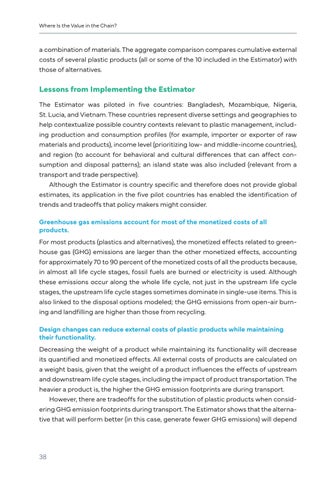Where Is the Value in the Chain?
a combination of materials. The aggregate comparison compares cumulative external costs of several plastic products (all or some of the 10 included in the Estimator) with those of alternatives.
Lessons from Implementing the Estimator The Estimator was piloted in five countries: Bangladesh, Mozambique, Nigeria, St. Lucia, and Vietnam. These countries represent diverse settings and geographies to help contextualize possible country contexts relevant to plastic management, including production and consumption profiles (for example, importer or exporter of raw materials and products), income level (prioritizing low- and middle-income countries), and region (to account for behavioral and cultural differences that can affect consumption and disposal patterns); an island state was also included (relevant from a transport and trade perspective). Although the Estimator is country specific and therefore does not provide global estimates, its application in the five pilot countries has enabled the identification of trends and tradeoffs that policy makers might consider. Greenhouse gas emissions account for most of the monetized costs of all products. For most products (plastics and alternatives), the monetized effects related to greenhouse gas (GHG) emissions are larger than the other monetized effects, accounting for approximately 70 to 90 percent of the monetized costs of all the products because, in almost all life cycle stages, fossil fuels are burned or electricity is used. Although these emissions occur along the whole life cycle, not just in the upstream life cycle stages, the upstream life cycle stages sometimes dominate in single-use items. This is also linked to the disposal options modeled; the GHG emissions from open-air burning and landfilling are higher than those from recycling. Design changes can reduce external costs of plastic products while maintaining their functionality. Decreasing the weight of a product while maintaining its functionality will decrease its quantified and monetized effects. All external costs of products are calculated on a weight basis, given that the weight of a product influences the effects of upstream and downstream life cycle stages, including the impact of product transportation. The heavier a product is, the higher the GHG emission footprints are during transport. However, there are tradeoffs for the substitution of plastic products when considering GHG emission footprints during transport. The Estimator shows that the alternative that will perform better (in this case, generate fewer GHG emissions) will depend
38





